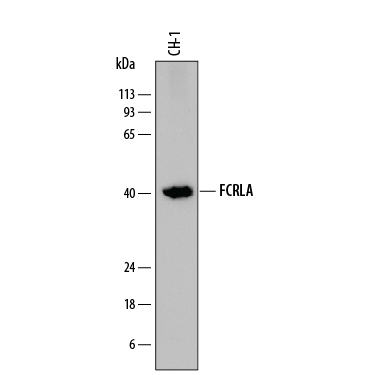Mouse FCRLA Antibody Summary
Lys221-Lys352
Accession # Q920A9
Applications
Please Note: Optimal dilutions should be determined by each laboratory for each application. General Protocols are available in the Technical Information section on our website.
Scientific Data
 View Larger
View Larger
Detection of Mouse FCRLA by Western Blot. Western blot shows lysates of CH-1 mouse B cell lymphoma cell line. PVDF membrane was probed with 2 µg/mL of Rat Anti-Mouse FCRLA Monoclonal Antibody (Catalog # MAB7905) followed by HRP-conjugated Anti-Rat IgG Secondary Antibody (Catalog # HAF005). A specific band was detected for FCRLA at approximately 40 kDa (as indicated). This experiment was conducted under reducing conditions and using Immunoblot Buffer Group 1.
 View Larger
View Larger
Detection of FCRLA in Mouse Splenocytes by Flow Cytometry. Mouse splenocytes were stained with Rat Anti-Mouse B220/CD45R PE-conjugated Monoclonal Antibody (Catalog # FAB1217P) and either (A) Rat Anti-Mouse FCRLA Monoclonal Antibody (Catalog # MAB7905) or (B) Rat IgG2AIsotype Control (Catalog # MAB006) followed by Allophycocyanin-conjugated Anti-Rat IgG Secondary Antibody (Catalog # F0113). To facilitate intracellular staining, cells were fixed with paraformaldehyde and permeabilized with saponin.
Reconstitution Calculator
Preparation and Storage
- 12 months from date of receipt, -20 to -70 °C as supplied.
- 1 month, 2 to 8 °C under sterile conditions after reconstitution.
- 6 months, -20 to -70 °C under sterile conditions after reconstitution.
Background: FCRLA
FCRLA (Fc Receptor-Like A; also known as FcRX and Fc receptor Homolog Expressed in B cells) is a 44 kDa intracellular member of the Fc gamma RI class, FcR family, Immunoglobulin Superfamily of molecules. It is associated with B lineage cells, and has been identified in virtually all splenic B cells, peritoneal B1b and B2 B cells, and immature through mature bone marrow B cells. Not all cells show equal expression patterns. In the spleen, weak FCRLA expression occurs in naïve follicular and marginal zone B cells, and increases with activation state. FcRLA is suggested to act as an ER chaperone during antibody maturation, and is known to bind to IgM, IgA, and IgG prior to their secretion. Mouse FCRLA is synthesized as a 34 kDa, 322 amino acid (aa) precursor that contains a 30 aa signal sequence, two C2‑type Ig‑like domains (aa 80-169 and 182-26), and a C-terminal poly-Proline region (aa 289-294). Although there is no traditional ER retention signal, a viable substitute is assumed to exist at the N-terminus of the mature molecule. FCRLA is believed to exist naturally as a monomer; however, disulfide-linkage can occur during experimental manipulation. While four potential isoform variants are reported, it is unclear if any are actually expressed. One shows an Ala insertion after Ala28, a second shows an AlaIle substitution for aa 20-22, a third contains that previous AlaIle substitution coupled to a deletion of aa 90-115, while a fourth utilizes an alternative start site at Met62. Over aa 221-352, mouse FCRLA shares 68% and 55% aa sequence identity with rat and human FCRLA, respectively.
Product Datasheets
FAQs
No product specific FAQs exist for this product, however you may
View all Antibody FAQsReviews for Mouse FCRLA Antibody
There are currently no reviews for this product. Be the first to review Mouse FCRLA Antibody and earn rewards!
Have you used Mouse FCRLA Antibody?
Submit a review and receive an Amazon gift card.
$25/€18/£15/$25CAN/¥75 Yuan/¥1250 Yen for a review with an image
$10/€7/£6/$10 CAD/¥70 Yuan/¥1110 Yen for a review without an image

